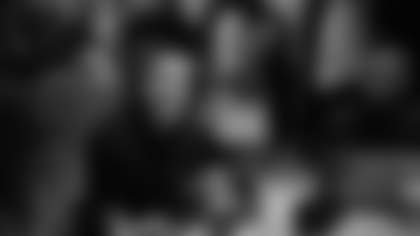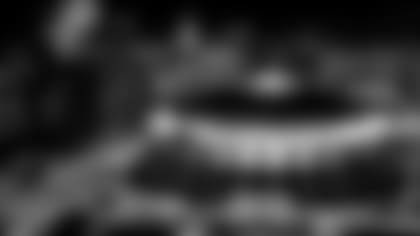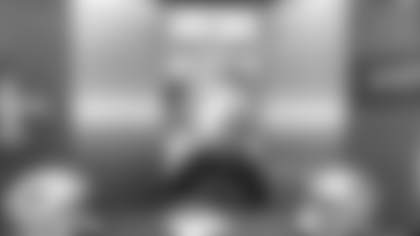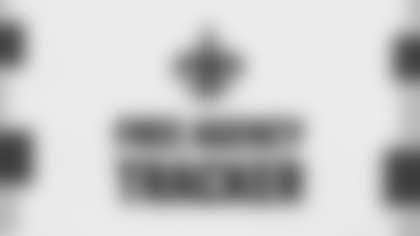New Orleans Saints Head Coach Sean Payton
Training Camp Presented By Verizon Media Availability
Tuesday, July 29, 2014
Opening Statement: "Both Jairus Byrd and Tavon Rooks came onto the roster today, both passing their physicals. We will just be smart about the reps like we would any player coming back."
What are your thoughts on having him (Jairus Byrd) on the field today?
"Obviously, the sooner the better when he is recovering. I am glad we did the procedure when we did rather than try to get through the season in a maintenance mode. I know he feels better and yet we still have to be smart. We have a lot of time and a lot of things that we have to do and a lot of things that he has to be able to catch up on. He is a quick study. He has been attentive in all of the meetings. It is good having him out here."
Would Jairus Byrd be the emergency punt returner?
"He played that role in Buffalo so I don't just want to put him in that role. The first day you can see that he catches it pretty naturally. Those ball skills that we see at free safety, you kind of see a punt returner. It potentially could be something he does and yet maybe it is more significant than that. I thought he fielded the punts real well."
Can you talk about Jairus Byrd is already being vocal?
"It's a strength of his. Now it is just physically transitioning back into football playing shape."
Can you talk about how important it was to match the offer for Rafael Bush?
"There are a handful of things that come into play. Number one, we think he is a real good safety and we have time on task developing him. He's also someone that can play in our three safety package. He is also someone that is outstanding in the kicking game. Really it was about his overall ability as a football player and his skillset as a football player. Oftentimes when it is another team in the division, you really have to eliminate that from swaying you with regards to whether you decide you're going to match the offer or not. And to his credit, he's really improved and really has good football instincts. He is someone that will be very important to us in the role he plays both as a safety and also as a special teams player."
It seems like this has been one of the better practices I've seen offensively and defensively.
"One of the things that I felt about today's practice just on the field watching it is there were moments for each side of the ball. When momentum started in one direction, the other side of the ball was able to come up with a stop or a play. We will look at the tape. I am sure, like it always does, when you feel like it was really good there will be things you know you have to correct. I was pleased with the tempo. I was pleased with how guys were moving around."
Do you consider the bubble screen to be a long handoff?
"There's two elements, the bubble itself is the little throw behind the line of scrimmage where he is running wide. The middle screen is typically in the slot or out wide and he is getting in behind the linemen. Today we ran a middle screen, a wide receiver middle screen, and he (Brandin Cooks) was able to find his landmark. But no, that is a way to control pressure and pass rush."
Is Brandin Cooks as fast as you thought he would be?
"Yes, he can run. It is our job to get him in space and let him do that."
How unique is it to play middle linebacker in the NFL?
"They (Curtis Lofton and David Hawthorne) are experienced and there is a lot that goes on. Any time that you are playing multiple defenses, any time a formation changes strength there is a lot that goes on so those guys have to be smart enough to get the adjustments, get the calls, but also, communicate it. It is probably more challenging at home because of the noise."
How have the young quarterbacks (Logan Kilgore and Ryan Griffin) done in the first week?
"Pretty well. Ryan's certainly further along with what we are doing having been here a year. Kilgore, for someone who's come in as a rookie free agent, has done a good job with the limited reps he's receiving."
Have you seen a change with how guys are taking care of their bodies?
"It has changed a lot really. If you go back 15 years there was a time where even hydrating was viewed differently. The more we study soft tissue injuries, the more and more we look at ways to prevent them. That is one of the things that every year we are looking at. How do we eliminate the hamstrings? How do we eliminate those injuries that maybe slow a player up for a week or two? Nutrition goes into that, rest, there are a number of things, and I would say that we are still learning too. We are still really paying attention to how we can improve that area."
Were you in that salt tablet generation?
"I was not, but see Bobby (Hebert) is older than I am. I was in that generation where you didn't take a water break or that was a sign of weakness if you bent over and you drank water. Obviously that was silly, they just didn't know it at the time."
How much growth have you seen from the d-line?
"Quite a bit. Defeinitely in a positive way. With Cam (Jordan) he is someone that can get on an edge. He is very good at applying pressure and he is very athletic inside. Akiem (Hicks) for him, it is the improvement of technique, pad level, just with his experience of playing he has such size that when he uses his technique and gets his pad level down he can be really really difficult to block."
Take us through the back shoulder throw from Drew Brees to Brandin Cooks and the coverage by Champ Bailey?
"We're not the first. When you start getting the bump and run coverage we get, it is hit or miss with the deep go route. Pretty soon you begin to locate a little bit behind him. The team that does a great job of defending that in press coverage is Seattle. They are really good with their eyes around. They play a couple different techniques that can fool you and kind of bait you into that throw. I thought Drew (Brees) and Brandin (Cooks) made a real good play handling the bump. And Champ, like you said, was in position (to defend it). It's tough to stay on top, stay on top when you're in press and be able to handle that type of throw which if you went way back it was like that underthrown go route where everything stopped and came back to the ball and it puts the defender in a tough position often times the potential penalty is called."
What did you know about Seantavius Jones before?
"So many times we sit in those meetings and it's the area scout that has a background. This goes back to even drafting Jimmy Graham. Someone has a passion for a player and believes strongly in a player whether it is a draft pick or a highly sought after free agent because when the draft ends we're not calling every free agent. There's an order. The guys that are in those areas year round they will have a player or two they really want to stand on the table for. We've done a good job with later round (draft picks and) free agent players. We've been able to develop those guys and they've found their way on the roster, no different than with him (Jones). An area scout starts with a recommendation and then it is us really creating the vision."
Who was the area scout?
"There were two. I don't want to give you the wrong area scout. I will get it to you so you can complete the story. It would always go area scout and then it would be the cross check scouts. There would be at least two reports, probably in his case four."
What do you like about Seantavius Jones?
"He had an injury that limited his production his last year compared to his junior year. He's a player that might have been drafted had he not had the injury that set him back a little bit in his final year. I like his size. We have a couple of those young receivers that are long and they give you a good throwing radius."
Can you talk about Brandin Cooks's mental adjustment to the program?
"It is still making sure that you are working him at one specific position. You have to really be able to look at the formations. We've lined him up at X a few times he has come inside based on the way the formation has been called. He's handled the install, especially for not having been here for some of the spring work. He was in San Diego with Drew (Brees) this summer, but it is still a transition."
A few years ago would you have been more hesitant to do the surgery on Jairus Byrd?
"I think the procedure he had done was not necessarily a different decision or process than it would have been five years ago. Now, I think that the maintenance element that is required without it is something that is all of a sudden you are kind of playing with this pain. It is important. The most important piece to the equation is the communication from the player. How it is feeling, how it is affecting him and then finding the doctor he feels comfortable with that has a conviction to how it can be repaired. We felt really good about the diagnosis and then the decision with regards to the procedure. I don't know how much that would have changed five years ago or further back."













